Yi Cao
Towards Practical Large-scale Dynamical Heterogeneous Graph Embedding: Cold-start Resilient Recommendation
Dec 15, 2025Abstract:Deploying dynamic heterogeneous graph embeddings in production faces key challenges of scalability, data freshness, and cold-start. This paper introduces a practical, two-stage solution that balances deep graph representation with low-latency incremental updates. Our framework combines HetSGFormer, a scalable graph transformer for static learning, with Incremental Locally Linear Embedding (ILLE), a lightweight, CPU-based algorithm for real-time updates. HetSGFormer captures global structure with linear scalability, while ILLE provides rapid, targeted updates to incorporate new data, thus avoiding costly full retraining. This dual approach is cold-start resilient, leveraging the graph to create meaningful embeddings from sparse data. On billion-scale graphs, A/B tests show HetSGFormer achieved up to a 6.11% lift in Advertiser Value over previous methods, while the ILLE module added another 3.22% lift and improved embedding refresh timeliness by 83.2%. Our work provides a validated framework for deploying dynamic graph learning in production environments.
USD: A User-Intent-Driven Sampling and Dual-Debiasing Framework for Large-Scale Homepage Recommendations
Jul 09, 2025

Abstract:Large-scale homepage recommendations face critical challenges from pseudo-negative samples caused by exposure bias, where non-clicks may indicate inattention rather than disinterest. Existing work lacks thorough analysis of invalid exposures and typically addresses isolated aspects (e.g., sampling strategies), overlooking the critical impact of pseudo-positive samples - such as homepage clicks merely to visit marketing portals. We propose a unified framework for large-scale homepage recommendation sampling and debiasing. Our framework consists of two key components: (1) a user intent-aware negative sampling module to filter invalid exposure samples, and (2) an intent-driven dual-debiasing module that jointly corrects exposure bias and click bias. Extensive online experiments on Taobao demonstrate the efficacy of our framework, achieving significant improvements in user click-through rates (UCTR) by 35.4\% and 14.5\% in two variants of the marketing block on the Taobao homepage, Baiyibutie and Taobaomiaosha.
A Generative Re-ranking Model for List-level Multi-objective Optimization at Taobao
May 12, 2025Abstract:E-commerce recommendation systems aim to generate ordered lists of items for customers, optimizing multiple business objectives, such as clicks, conversions and Gross Merchandise Volume (GMV). Traditional multi-objective optimization methods like formulas or Learning-to-rank (LTR) models take effect at item-level, neglecting dynamic user intent and contextual item interactions. List-level multi-objective optimization in the re-ranking stage can overcome this limitation, but most current re-ranking models focus more on accuracy improvement with context. In addition, re-ranking is faced with the challenges of time complexity and diversity. In light of this, we propose a novel end-to-end generative re-ranking model named Sequential Ordered Regression Transformer-Generator (SORT-Gen) for the less-studied list-level multi-objective optimization problem. Specifically, SORT-Gen is divided into two parts: 1)Sequential Ordered Regression Transformer innovatively uses Transformer and ordered regression to accurately estimate multi-objective values for variable-length sub-lists. 2)Mask-Driven Fast Generation Algorithm combines multi-objective candidate queues, efficient item selection and diversity mechanism into model inference, providing a fast online list generation method. Comprehensive online experiments demonstrate that SORT-Gen brings +4.13% CLCK and +8.10% GMV for Baiyibutie, a notable Mini-app of Taobao. Currently, SORT-Gen has been successfully deployed in multiple scenarios of Taobao App, serving for a vast number of users.
M2IV: Towards Efficient and Fine-grained Multimodal In-Context Learning in Large Vision-Language Models
Apr 06, 2025Abstract:Multimodal in-context learning (ICL) is a vital capability for Large Vision-Language Models (LVLMs), allowing task adaptation via contextual prompts without parameter retraining. However, its application is hindered by the token-intensive nature of inputs and the high complexity of cross-modal few-shot learning, which limits the expressive power of representation methods. To tackle these challenges, we propose \textbf{M2IV}, a method that substitutes explicit demonstrations with learnable \textbf{I}n-context \textbf{V}ectors directly integrated into LVLMs. By exploiting the complementary strengths of multi-head attention (\textbf{M}HA) and multi-layer perceptrons (\textbf{M}LP), M2IV achieves robust cross-modal fidelity and fine-grained semantic distillation through training. This significantly enhances performance across diverse LVLMs and tasks and scales efficiently to many-shot scenarios, bypassing the context window limitations. We also introduce \textbf{VLibrary}, a repository for storing and retrieving M2IV, enabling flexible LVLM steering for tasks like cross-modal alignment, customized generation and safety improvement. Experiments across seven benchmarks and three LVLMs show that M2IV surpasses Vanilla ICL and prior representation engineering approaches, with an average accuracy gain of \textbf{3.74\%} over ICL with the same shot count, alongside substantial efficiency advantages.
PIP: Perturbation-based Iterative Pruning for Large Language Models
Jan 25, 2025Abstract:The rapid increase in the parameter counts of Large Language Models (LLMs), reaching billions or even trillions, presents significant challenges for their practical deployment, particularly in resource-constrained environments. To ease this issue, we propose PIP (Perturbation-based Iterative Pruning), a novel double-view structured pruning method to optimize LLMs, which combines information from two different views: the unperturbed view and the perturbed view. With the calculation of gradient differences, PIP iteratively prunes those that struggle to distinguish between these two views. Our experiments show that PIP reduces the parameter count by approximately 20% while retaining over 85% of the original model's accuracy across varied benchmarks. In some cases, the performance of the pruned model is within 5% of the unpruned version, demonstrating PIP's ability to preserve key aspects of model effectiveness. Moreover, PIP consistently outperforms existing state-of-the-art (SOTA) structured pruning methods, establishing it as a leading technique for optimizing LLMs in environments with constrained resources. Our code is available at: https://github.com/caoyiiiiii/PIP.
HAIR: Hypernetworks-based All-in-One Image Restoration
Aug 15, 2024

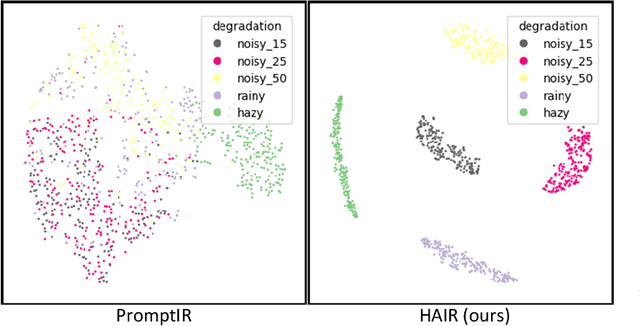
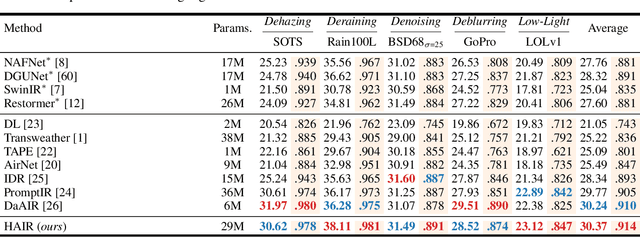
Abstract:Image restoration involves recovering a high-quality clean image from its degraded version, which is a fundamental task in computer vision. Recent progress in image restoration has demonstrated the effectiveness of learning models capable of addressing various degradations simultaneously, i.e., the All-in-One image restoration models. However, these existing methods typically utilize the same parameters facing images with different degradation types, which causes the model to be forced to trade off between degradation types, therefore impair the total performance. To solve this problem, we propose HAIR, a Hypernetworks-based plug-in-and-play method that dynamically generated parameters for the corresponding networks based on the contents of input images. HAIR consists of 2 main components: Classifier (Cl) and Hyper Selecting Net (HSN). To be more specific, the Classifier is a simple image classification network which is used to generate a Global Information Vector (GIV) that contains the degradation information of the input image; And the HSNs can be seen as a simple Fully-connected Neural Network that receive the GIV and output parameters for the corresponding modules. Extensive experiments shows that incorporating HAIR into the architectures can significantly improve the performance of different models on image restoration tasks at a low cost, \textbf{although HAIR only generate parameters and haven't change these models' logical structures at all.} With incorporating HAIR into the popular architecture Restormer, our method obtains superior or at least comparable performance to current state-of-the-art methods on a range of image restoration tasks. \href{https://github.com/toummHus/HAIR}{\textcolor{blue}{$\underline{\textbf{Code and pre-trained checkpoints are available here.}}$}}
SparseSSP: 3D Subcellular Structure Prediction from Sparse-View Transmitted Light Images
Jul 03, 2024



Abstract:Traditional fluorescence staining is phototoxic to live cells, slow, and expensive; thus, the subcellular structure prediction (SSP) from transmitted light (TL) images is emerging as a label-free, faster, low-cost alternative. However, existing approaches utilize 3D networks for one-to-one voxel level dense prediction, which necessitates a frequent and time-consuming Z-axis imaging process. Moreover, 3D convolutions inevitably lead to significant computation and GPU memory overhead. Therefore, we propose an efficient framework, SparseSSP, predicting fluorescent intensities within the target voxel grid in an efficient paradigm instead of relying entirely on 3D topologies. In particular, SparseSSP makes two pivotal improvements to prior works. First, SparseSSP introduces a one-to-many voxel mapping paradigm, which permits the sparse TL slices to reconstruct the subcellular structure. Secondly, we propose a hybrid dimensions topology, which folds the Z-axis information into channel features, enabling the 2D network layers to tackle SSP under low computational cost. We conduct extensive experiments to validate the effectiveness and advantages of SparseSSP on diverse sparse imaging ratios, and our approach achieves a leading performance compared to pure 3D topologies. SparseSSP reduces imaging frequencies compared to previous dense-view SSP (i.e., the number of imaging is reduced up to 87.5% at most), which is significant in visualizing rapid biological dynamics on low-cost devices and samples.
ECAT: A Entire space Continual and Adaptive Transfer Learning Framework for Cross-Domain Recommendation
Jul 02, 2024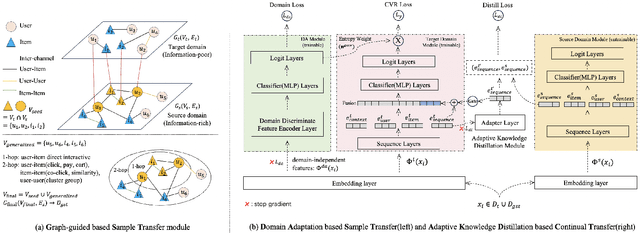
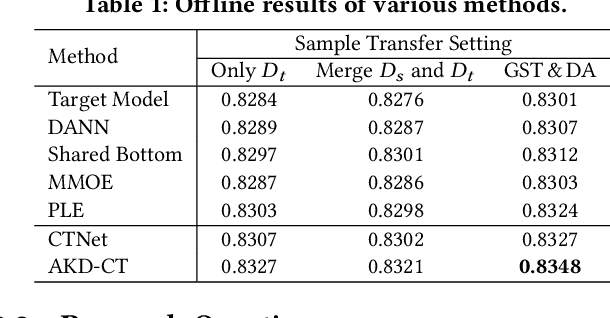

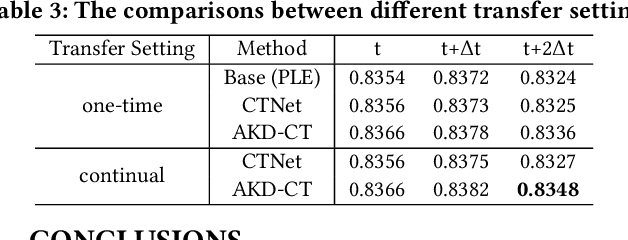
Abstract:In industrial recommendation systems, there are several mini-apps designed to meet the diverse interests and needs of users. The sample space of them is merely a small subset of the entire space, making it challenging to train an efficient model. In recent years, there have been many excellent studies related to cross-domain recommendation aimed at mitigating the problem of data sparsity. However, few of them have simultaneously considered the adaptability of both sample and representation continual transfer setting to the target task. To overcome the above issue, we propose a Entire space Continual and Adaptive Transfer learning framework called ECAT which includes two core components: First, as for sample transfer, we propose a two-stage method that realizes a coarse-to-fine process. Specifically, we perform an initial selection through a graph-guided method, followed by a fine-grained selection using domain adaptation method. Second, we propose an adaptive knowledge distillation method for continually transferring the representations from a model that is well-trained on the entire space dataset. ECAT enables full utilization of the entire space samples and representations under the supervision of the target task, while avoiding negative migration. Comprehensive experiments on real-world industrial datasets from Taobao show that ECAT advances state-of-the-art performance on offline metrics, and brings +13.6% CVR and +8.6% orders for Baiyibutie, a famous mini-app of Taobao.
InfRS: Incremental Few-Shot Object Detection in Remote Sensing Images
May 18, 2024Abstract:Recently, the field of few-shot detection within remote sensing imagery has witnessed significant advancements. Despite these progresses, the capacity for continuous conceptual learning still poses a significant challenge to existing methodologies. In this paper, we explore the intricate task of incremental few-shot object detection in remote sensing images. We introduce a pioneering fine-tuningbased technique, termed InfRS, designed to facilitate the incremental learning of novel classes using a restricted set of examples, while concurrently preserving the performance on established base classes without the need to revisit previous datasets. Specifically, we pretrain the model using abundant data from base classes and then generate a set of class-wise prototypes that represent the intrinsic characteristics of the data. In the incremental learning stage, we introduce a Hybrid Prototypical Contrastive (HPC) encoding module for learning discriminative representations. Furthermore, we develop a prototypical calibration strategy based on the Wasserstein distance to mitigate the catastrophic forgetting problem. Comprehensive evaluations on the NWPU VHR-10 and DIOR datasets demonstrate that our model can effectively solve the iFSOD problem in remote sensing images. Code will be released.
Few-shot Oriented Object Detection with Memorable Contrastive Learning in Remote Sensing Images
Mar 20, 2024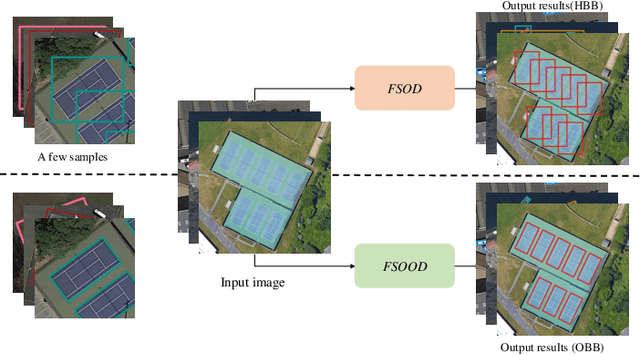
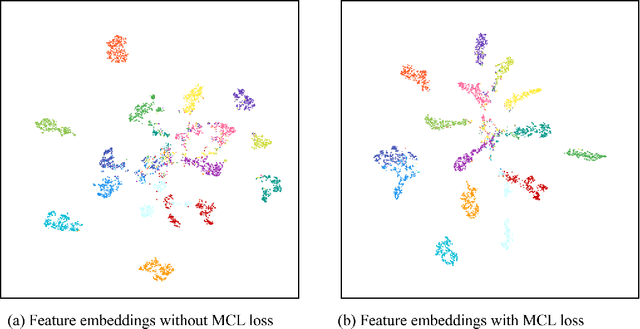
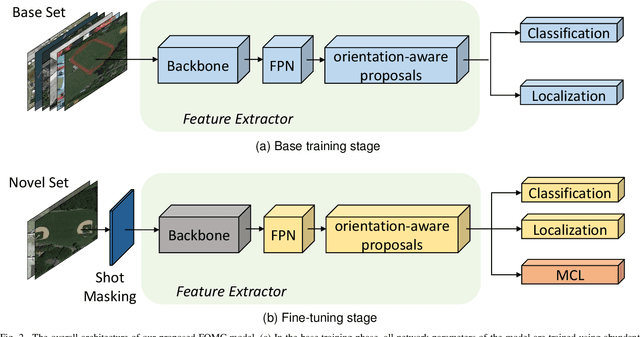
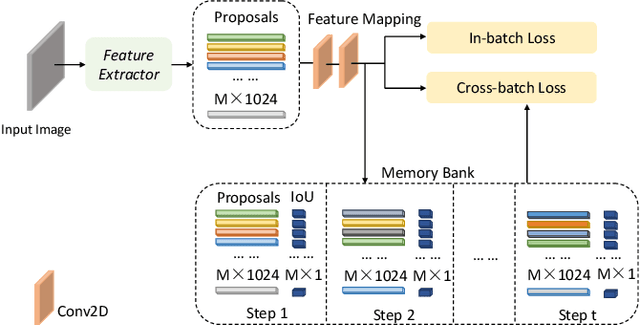
Abstract:Few-shot object detection (FSOD) has garnered significant research attention in the field of remote sensing due to its ability to reduce the dependency on large amounts of annotated data. However, two challenges persist in this area: (1) axis-aligned proposals, which can result in misalignment for arbitrarily oriented objects, and (2) the scarcity of annotated data still limits the performance for unseen object categories. To address these issues, we propose a novel FSOD method for remote sensing images called Few-shot Oriented object detection with Memorable Contrastive learning (FOMC). Specifically, we employ oriented bounding boxes instead of traditional horizontal bounding boxes to learn a better feature representation for arbitrary-oriented aerial objects, leading to enhanced detection performance. To the best of our knowledge, we are the first to address oriented object detection in the few-shot setting for remote sensing images. To address the challenging issue of object misclassification, we introduce a supervised contrastive learning module with a dynamically updated memory bank. This module enables the use of large batches of negative samples and enhances the model's capability to learn discriminative features for unseen classes. We conduct comprehensive experiments on the DOTA and HRSC2016 datasets, and our model achieves state-of-the-art performance on the few-shot oriented object detection task. Code and pretrained models will be released.
 Add to Chrome
Add to Chrome Add to Firefox
Add to Firefox Add to Edge
Add to Edge